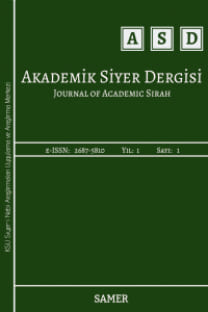Hz. Peygamber’in Davetine Diğer Dinî Grupların Tepkisi -Ömer Nasuhi Bilmen’in Tefsiri Özelinde-
Hz. Peygamber’in sireti ve yaşadığı topluma dair mâlûmat siyer Müelliflerinin eserleriyle sınırlı değildir. Dönemin olaylarına zaman zaman gerek bireysel gerekse toplumsal düzeyde yer veren Kur’ân vahyi, siyer ilmi açısından birincil ve en güvenilir kaynaktır. Bu bağlamda Kuran âyetlerini inceleyen müfessirlerin Hz. Peygamber dönemini ele alış biçimleri ve olaylara getirdikleri yorumlar, siyer anlatılarının çeşitliliğini arttırmıştır. Ömer Nasuhi Bilmen’in sekiz ciltlik eseri Kur’an-ı Kerim’in Türkçe Meâli Âlîsi ve Tefsiri sebeb-i nüzûllerin ele alınışı sırasında yer verdiği siyer rivayetleri ve dönemin toplumsal yapısının genişçe tahliliyle tefsir eserleri arasında önemli bir yere sahiptir. Çalışmamızda Müellif’in siyer rivayetlerine yaklaşımını, Hz. Peygamber ve dönemine dair değerlendirmelerini, âyetleri sebeb-i nüzûl bağlamında nasıl yorumladığını, eserinde ortaya koyduğu katkı ve farklılıklara yer vermeye çalışarak ele alacağız.
Anahtar Kelimeler:
siyer, sebeb-i nüzul, Hz. Peygamber, tefsir, Ömer Nasuhi Bilmen
Hz. Peygamber’in Davetine Diğer Dinî Grupların Tepkisi -Ömer Nasuhi Bilmen’in Tefsiri Özelinde- The Response of Other Religious Groups to the Invitation of the Prophet - Specific to Ömer Nasuhi Bilmen's Tafsir-
Information about the life of the Prophet (phub) and the society in which he lived is not limited to the works of the sīrah. The Qur’anic revelation, which sometimes includes the events of the period on an individual or social level, is the primary and most reliable source in terms of being a source for sīrah. In this context, the way tafsir, which is a science that examines the verses of the Qur’an, handles the period of the Prophet (pbuh) and the interpretations they bring to the events, has increased the diversity of the sīrah narratives. Omer Nasuhi Bilmen’s eight-volume work titled "The Turkish Exalted Translation of the Qur’an and its Tafsir" (Kur’an-ı Kerim’in Türkçe Meâli Âlîsi ve Tefsiri) has an important place among the tafsir works with the sirah narrations mentioned when the occasions of revelation of verses (Asbab al-Nuzūl) are explained and the social structure of the period are analyzed extensively. In our study, we will deal with the Bilmen’s approach to the narrations of the sīrah, his evaluations of the Prophet (pbuh) and his period, and how he interpreted the verses in the context of the occasions of revelation, by trying to include the contributions and differences he made in his work
Keywords:
Sirah, Prophet (pbuh), Ömer Nasuhi Bilmen, Tafsir, the occasions of revelations (asbab al-nuzul),
___
- Atalay, Orhan. “Ömer Nasuhî Bilmen’in Tefsirinde İçtimaî Boyut”. Türk-İslam Düşünce Tarihinde Erzurum Sempozyumu. 1/173. Erzurum: y.y., 2007.
- Aydüz, Davut. “Ömer Nasûhi Bilmen’in Kur’ân-ı Kerim’in Türkçe Meâl-i Âlisi ve Tefsîri". Diyanet İlmi Dergi. 2/101-110. 2003.
- Bilmen, Ömer Nasuhi. Kur’an-ı Kerim’in Türkçe Meâli Âlîsi ve Tefsiri. 8 Cilt. İstanbul: Nesa Yay., ts.
- Demircan, Adnan. Hz. Peygamber Döneminde Münafıklar. İstanbul: Beyan Yay., 2016.
- Dumlu, Ömer. “Ömer Nasuhi Bilmen’in Tefsiri Halk İçin mi Yazıldı?”. Türk-İslam Düşünce Tarihinde Erzurum Sempozyumu. 1/ 150-168. Erzurum: y.y., 2007.
- Eroğlu, Ali. “Ömer Nasuhi Bilmen’e Göre İdeal Bir Tefsir Nasıl Olmalıdır?”. Türk-İslam Düşünce Tarihinde Erzurum Sempozyumu. 1/156. Erzurum: y.y., 2007.
- Günay, Bektaş. Ömer Nasuhi Bilmen ve Tefsiri. Konya: Selçuk Üniversitesi, Sosyal Bilimler Enstitüsü, Yüksek Lisans Tezi, 2001.
- Özkuyumcu, Nadir. “Nadîr (Benî Nadîr)”. Türkiye Diyanet Vakfı İslâm Ansiklopedisi. 32/275. İstanbul: TDV Yay., 2006.
- Yaran, Rahmi. “Ömer Nasuhi Bilmen”. Türkiye Diyanet Vakfı İslâm Ansiklopedisi. 6/162-163. İstanbul: TDV Yay., 1992.
- Yaşar, Serkan. “Ömer Nasuhî Bilmen’in Tefsirinde Tarih ve Siyer Bilgilerinin Değerlendirilmesi”, Türk-İslam Düşünce Tarihinde Erzurum Sempozyumu. 1/300. Erzurum: y.y., 2007.
- Yayın Aralığı: Yılda 2 Sayı
- Başlangıç: 2020
- Yayıncı: Kahramanmaraş Sütçü İmam Üniversitesi
Sayıdaki Diğer Makaleler
Osmanlı Hayırseverlik Kültüründe Hz. Peygamber (s.a.s) ile İlgili Uygulamalar
Hz. Peygamber’in Davetine Diğer Dinî Grupların Tepkisi -Ömer Nasuhi Bilmen’in Tefsiri Özelinde-
Ürdün Fetihlerinde Şürahbîl b. Hasene
Cumhuriyet Dönemi Siyer Yazıcılığında Bir Metin Türü: Muharref Siyer Metinleri
